Fuel Performance Analysis of Fast Flux Test Facility MFF-3 and -5 Fuel Pins Using BISON with Post Irradiation Examination Data
Abstract
:1. Introduction
2. Methods
2.1. FFTF MFF-3 and MFF-5 Irradiation Data for BISON Input Parameters
2.2. General Solution Approach
2.3. U-Pu-Zr Hot-Pressing Model
2.4. Cladding Profilometry Assessment
3. Results
Burnup and Fission Gas Release
4. Axial Fuel Swelling and Cladding Profilometry
5. Discussion
6. Conclusions
Author Contributions
Funding
Data Availability Statement
Acknowledgments
Conflicts of Interest
Disclosure Statement
Abbreviations
| ANL | Argonne National Laboratory |
| BOC | Beginning of Cycle |
| EBR-II | Experimental Breeder Reactor-II |
| EFPD | Effective Fuel Power Day |
| EOC | End of Cycle |
| FCCI | Fuel-cladding Chemical Interaction |
| FCMI | Fuel-cladding Mechanical Interaction |
| FFTF | Fast-Flux Test Facility |
| FGC | Fission Gas Collected |
| FGP | Fission Gas Produced |
| FGR | Fission Gas Release |
| FIPD | Fuels Irradiation and Physics Database |
| GLASS | Germanium-Lithium Argon Scanning System |
| IMIS | Integral fast Reactor (IFR) Materials Information System |
| INL | Idaho National Laboratory |
| LHGR | Linear Heat Generation Rate |
| PIE | Post-Irradiation Examination |
| PNNL | Pacific Northwest National Laboratory |
| SEE | Standard Error of the Estimate |
| SFR | Sodium-cooled Fast Reactor |
| VTR | Versatile Test Reactor |
References
- Oaks, A.; Mo, K.; Mohamed, W.; Yacout, A. Development of FIPD: The EBR-II Fuels Irradiation & Physics Database. In Proceedings of the Top Fuel 2019: Light Water Reactor Fuel Performance Conference, Seattle, WA, USA, 22–27 September 2019. [Google Scholar]
- Paaren, K.M.; Gale, M.; Kerr, M.J.; Medvedev, P.G.; Porter, D.L. Initial demonstration of Automated fuel performance modeling with 1977 EBR-II metallic fuel pins using BISON code with FIPD and IMIS databases. Nucl. Eng. Des. 2021, 382, 111393. [Google Scholar] [CrossRef]
- Yacout, A.M.; Oaks, A.; Mohamed, W.; Mo, K. FIPD: EBR-II Fuels Irradiation & Physics Database; Argonne National Lab. (ANL): Argonne, IL, USA, 2017.
- Crawford, D.C.; Steven, L.; Powers, J.J. A Proposed Startup Fuel for the Versatile Test Reactor. Trans. Am. Nucl. Soc. 2018, 118, 1565–1566. [Google Scholar]
- Pitner, A.L.; Baker, R.B. Metal fuel test program in the FFTF. J. Nucl. Mater. 1993, 204, 124–130. [Google Scholar] [CrossRef]
- Wootan, D.W.; Nelson, J.V. Irradiation Data for the MFF-3 and MFF-5 Tests in the FFTF; Pacific Northwest National Laboratory: Richland, WA, USA, 2011.
- Laboratory, P.N.N. Fast Flux Test Facility. 2020. Available online: https://beta11.pnnl.gov/projects/fftf (accessed on 30 September 2021).
- Crawford, D.C.; Porter, D.L.; Hayes, S.L. Fuels for sodium-cooled fast reactors: US perspective. J. Nucl. Mater. 2007, 371, 202–231. [Google Scholar] [CrossRef]
- Porter, D.; Mariani, R.D. Archiving EBR-II Metallic Fuel Test Data Using NDMAS to Accelerate Fast Reactor Fuel Qualification; Idaho National Laboratory (INL): Idaho Falls, ID, USA, 2019.
- Paaren, K.M.; Black, A.; Lybeck, N.; Mo, K.; Spencer, B.W.; Medvedev, P.; Porter, D. BISON Fuel Performance Modeling Optimization for Experiment X447 and X447A Using Axial Swelling and Cladding Strain Measurements. Nucl. Eng. Des. 2021, 394, 111812. [Google Scholar] [CrossRef]
- Galloway, J.D.; Matthews, C. Enhancements to BISON U-Zr Metallic Fuel X447 Example Problem; Los Alamos National Lab. (LANL): Los Alamos, NM, USA, 2016.
- Paaren, K.M.; Lybeck, N.; Mo, K.; Medvedev, P.G.; Porter, D.L. Cladding Profilometry Analysis of EBR-II metallic fuel pins with HT9, D9, and SS316 cladding. Energies 2021, 14, 515. [Google Scholar] [CrossRef]
- Casagranda, A.; Novascone, S.R.; Zabriskie, A.X. Metallic Fuel Validation Plan. In Summary of Bison Milestones and Activities—NEAMS FY19 Report; Idaho National Laboratory (INL): Idaho Falls, ID, USA, 2019. [Google Scholar]
- Ogata, T.; Takeshi, Y. Development and Validation of ALFUS: An Irradiation Behavior Analysis code for Metallic Fast Reactor Fuels. Nucl. Technol. 1999, 128, 113–124. [Google Scholar] [CrossRef]
- Harp, J.M.; Porter, D.L.; Miller, B.D.; Trowbridge, T.L.; Carmack, W.J. Scanning electron microscopy examination of a Fast Flux Test Facility irradiated U-10Zr fuel cross section clad with HT-9. J. Nucl. Mater. 2017, 494, 227–239. [Google Scholar] [CrossRef]
- Hales, J.D.; Gamble, K.A.; Spencer, B.W.; Novascone, S.R.; Pastore, G.; Liu, W.; Stafford, D.S.; Williamson, R.L.; Perez, D.M.; Gardner, R.J. BISON Users Manual—BISON Release 1.2; Idaho National Laboratory: Idaho Falls, ID, USA, 2015.
- Williamson, R.L.; Hales, J.D.; Novascone, S.R.; Pastore, G.; Gamble, K.A.; Spencer, B.W.; Jiang, W.; Pitts, S.A.; Casagranda, A.; Schwen, D.; et al. BISON: A Flexible Code for Advanced Simulation of the Performance of Multiple Nuclear Fuel Forms. Nucl. Technol. 2021, 207, 954–980. [Google Scholar] [CrossRef]
- Novascone, S.R.; Casagranda, A.; Medvedev, P.G.; Matthews, C.; Zabriskie, A.X. Summary and Assessment of Metallic Fuel Capabilities in Bison Milestone Report; INL/EXT-18-51399; Idaho National Laboratory: Idaho Falls, ID, USA, 2018.
- Kim, A.M.; Soo, Y.; Hayes, S.L.; Hofman, G.L.; Yacout, A. Modeling of constituent redistribution in U-Pu-Zr metallic fuel. J. Nucl. Mater. 2006, 359, 17–28. [Google Scholar] [CrossRef]
- Billone, M.C.; Liu, Y.Y.; Gruber, E.E.; Hughes, T.H.; Kramer, J.M. Status of Fuel Element Modeling Codes for Metallic Fuels. In Proceedings of the American Nuclear Society International Conference on Reliable Fuels for Liquid Metal Reactors, Tucson, AZ, USA, 7–11 September 1968. [Google Scholar]
- Savage, H. The heat content and specific heat of some metallic fast-reactor fuels containing plutonium. J. Nucl. Mater. 1968, 25, 249–259. [Google Scholar] [CrossRef]
- Hofman, G.L.; Billone, M.C.; Koenig, J.F.; Kramer, J.M. Metallic Fuels Handbook; Argonne National Lab. (ANL): Argonne, IL, USA, 2019.
- Yamanouchi, N.; Tamura, M.; Hayakawa, H.; Kondo, T. Accumulation of engineering data for practical use of reduced activation ferritic steel: 8%Cr-2%W-0.2%V-0.04%Ta-Fe. J. Nucl. Mater. 1992, 191–194, 822–826. [Google Scholar] [CrossRef]
- Banerjee, A.; Raju, S.; Divakar, R.; Mohandas, E. High Temperature Heat Capacity of Alloy D9 Using Drop Calorimetry Based Enthalpy Increment Measurements. Int. J. Thermophys. 2007, 28, 98–108. [Google Scholar] [CrossRef]
- Leibowitz, L.; Blomquist, R.A. Thermal conductivity and thermal expansion of stainless steels D9 and HT9. Int. J. Thermophys. 1988, 9, 873–883. [Google Scholar] [CrossRef]
- Mills, K.C. Recommended Values of Thermophysical Properties for Selected Commercial Alloys; Woodhead Publishing: Shaston, UK, 2002. [Google Scholar]
- Olander, D.R. Fundamental Aspects of Nuclear Reactor Fuel Elements; Technical Information Center, Energy Research and Development Administration: Washington, DC, USA, 1976.
- Los Alamos National Laboratory. AFCI Materials Handbook, Materials Data for Particle Accelerator Applications, Chapter 18—Design Properties of HT9 and Russian Ferritic/Martensitic Steels, Rev 6; Los Alamos National Laboratory: Los Alamos, NM, USA, 2014.
- GeelHood, K.J.; Porter, I.E. Modeling and Assessment of EBR-II Fuel with the US NRC’s Fast Fuel Performance Code. In Proceedings of the Top Fuel, Prague, Czech Republic, 30 September–4 October 2018; p. 12. [Google Scholar]
- Karahan, A. Modeling of Thermo-Mechanical and Irradiation Behavior of Mixed Oxide Fuel for Sodium Fast Reactors; Massachusetts Institute of Technology: Cambridge, MA, USA, 2010. [Google Scholar]
- Hofman, G.L.; Walters, L.C.; Bauer, T.H. Metallic Fast Reactor Fuels. Prog. Nucl. Energy 1997, 31, 83–110. [Google Scholar] [CrossRef]
- Karahan, A.; Buongiorno, J. A new code for predicting the thermo-mechanical and irradiation behavior of metallic fuels in sodium fast reactors. J. Nucl. Mater. 2010, 396, 283–293. [Google Scholar] [CrossRef]
- Briggs, L.L.; Chang, Y.I.; Hill, D.J. Safety Analysis and Technical Basis for Establing an Interim Burnup Limit for Mark-V and Mark-VA Fueled Subassemblies in EBR-II; Argonne National Lab. (ANL): Argonne, IL, USA, 1995.
- Everitt, B.S.; Skrondal, A. The Cambridge Dictionary of Statistics, 4th ed.; Cambridge University Press: New York, NY, USA, 2010. [Google Scholar]
- Cohen, J. Statistical Power Analysis for the Behavioral Sciences, 2nd ed.; Academic Press: Cambridge, MA, USA, 1988. [Google Scholar]
- Matthews, C.; Galloway, J.; Unal, C.; Novascone, S.; Williamson, R. BISON for Metallic Fuels Modelling. In Fast Reactors and Related Fuel Cycles: Next Generation Nuclear Systems for Sustainable Development FR17 2017; International Atomic Energy Agency: Vienna, Austria, 2018. [Google Scholar]
- Galloway, J.D. Fully-Coupled Metallic Fuel Performance Simulations Using BISON, LA-UR-15-26773; Los Alamos National Lab. (LANL): Los Alamos, NM, USA, 2015.
- Matthews, C.; Unal, C. Initial Implementation of a Bubble-Surface Force-Balance Fission Gas Behavior Algorithm for Metallic Nuclear Fuel into BISON, LA-UR-19-31814; Los Alamos National Lab. (LANL): Los Alamos, NM, USA, 2019.
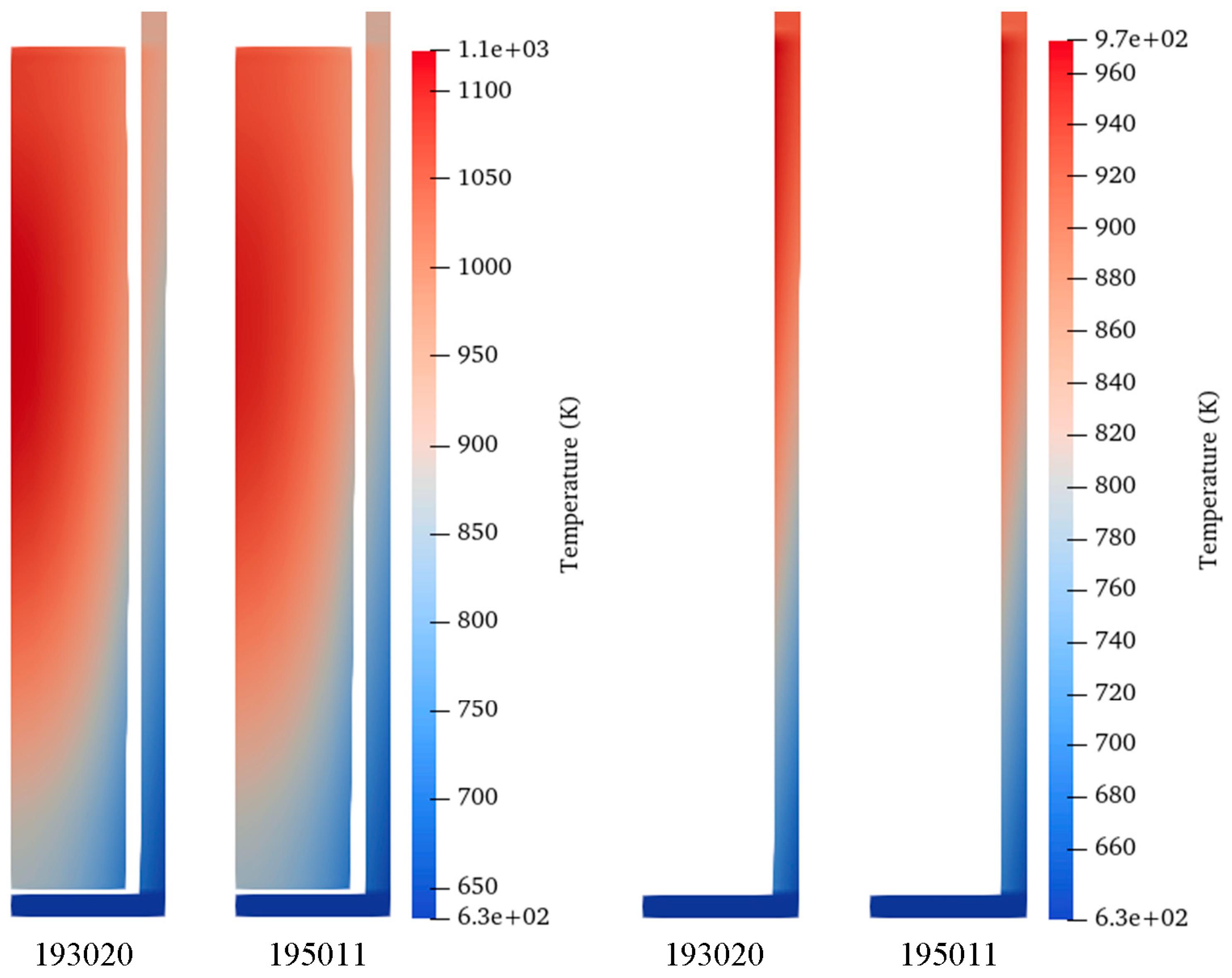
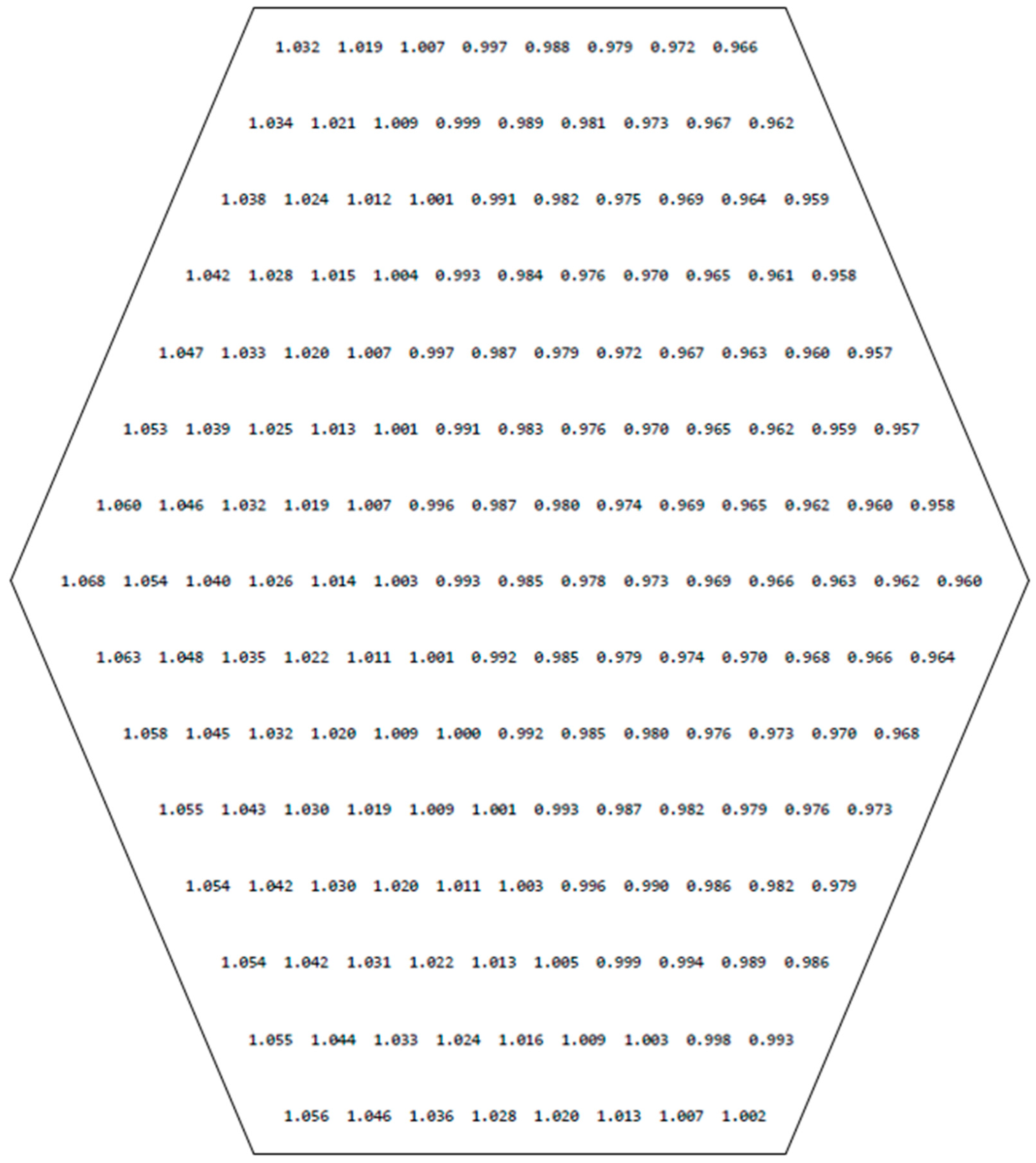
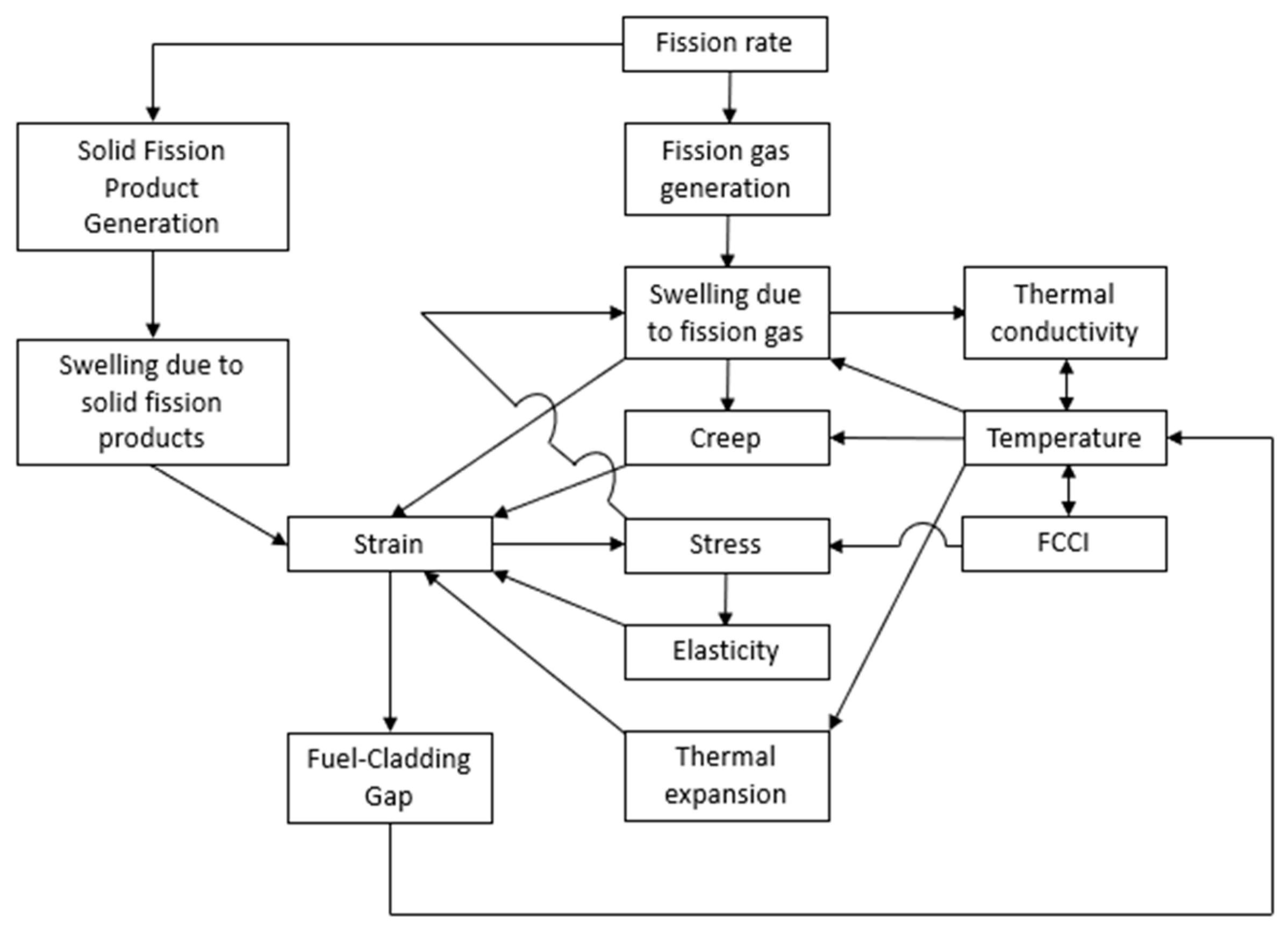
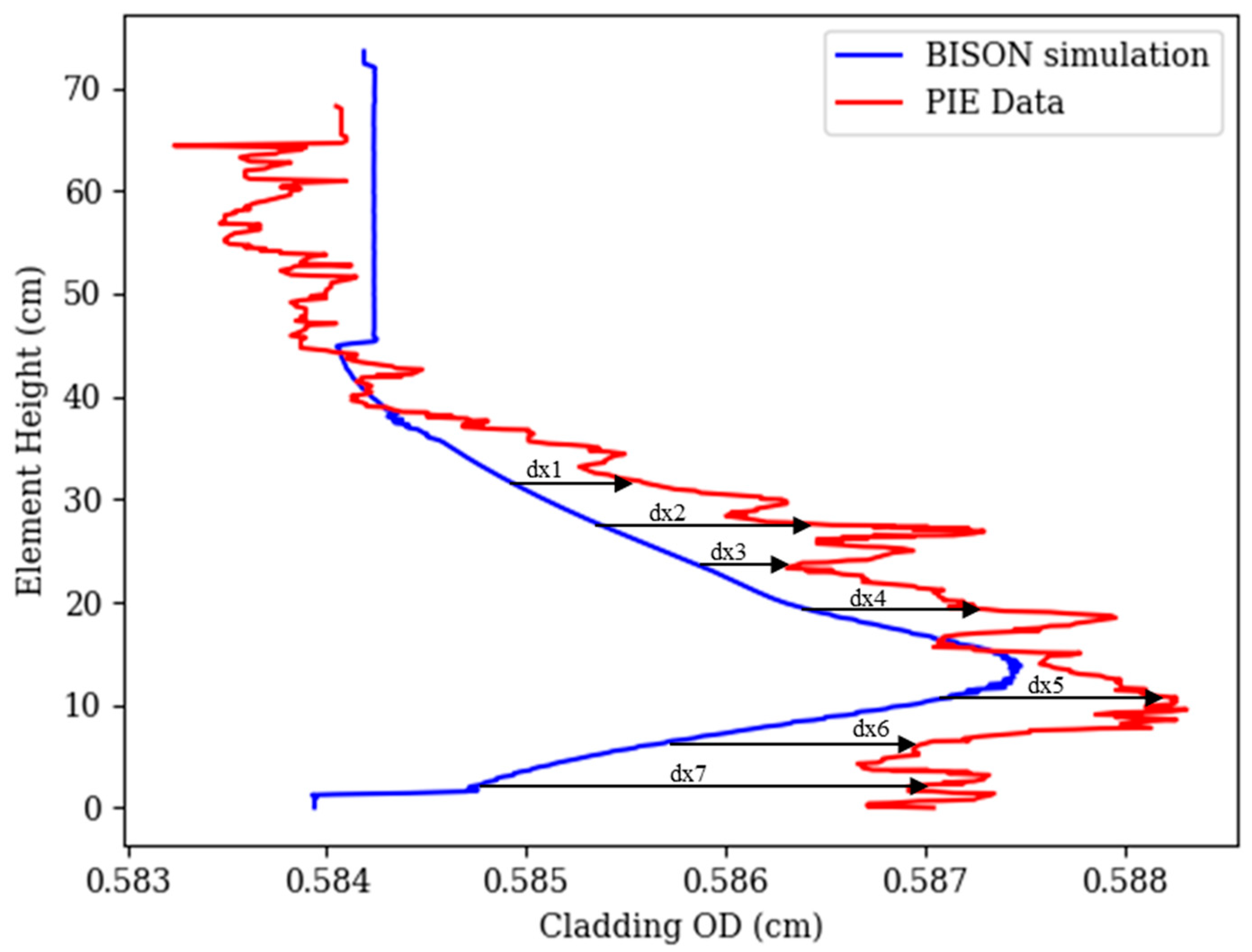
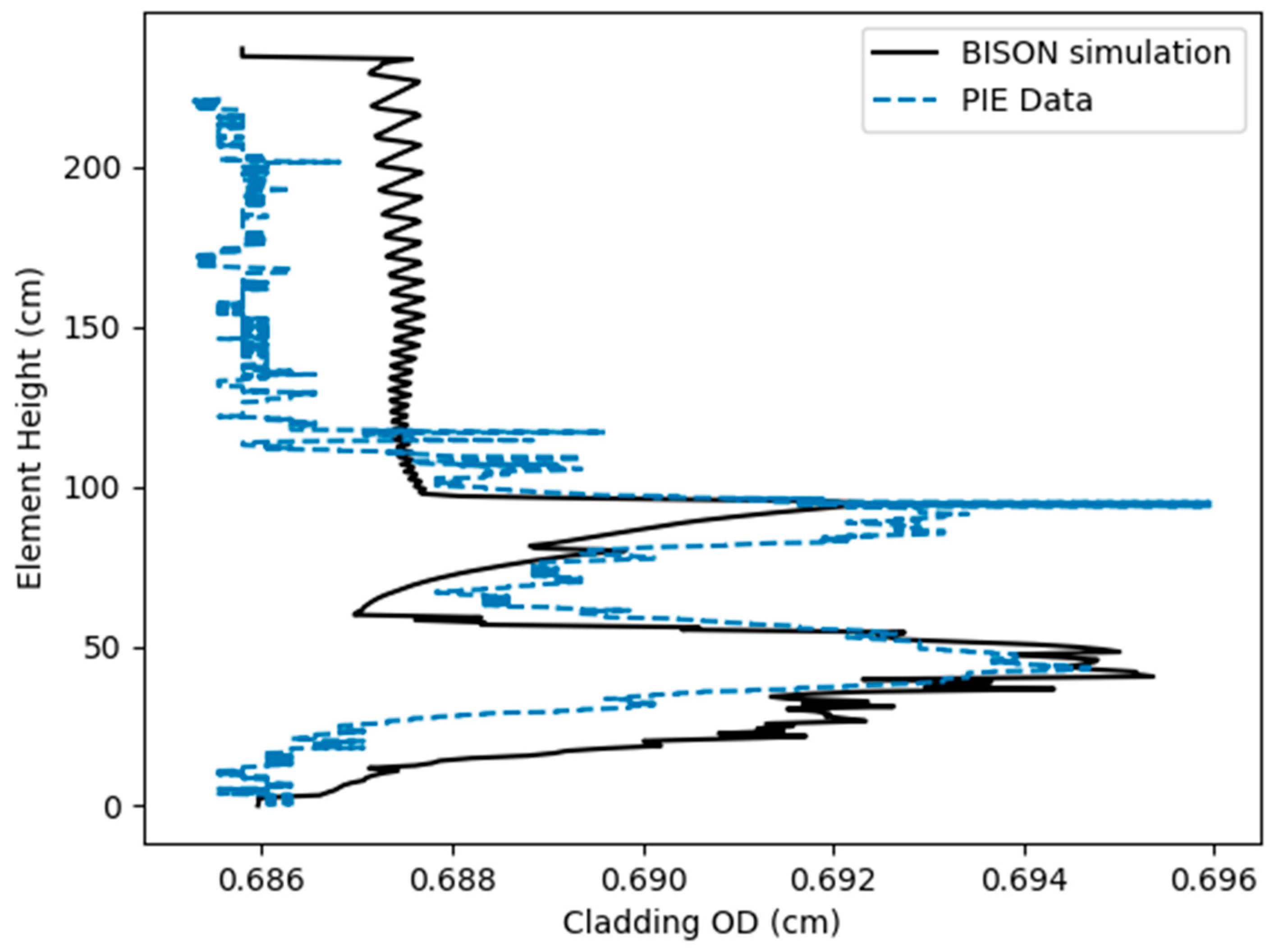
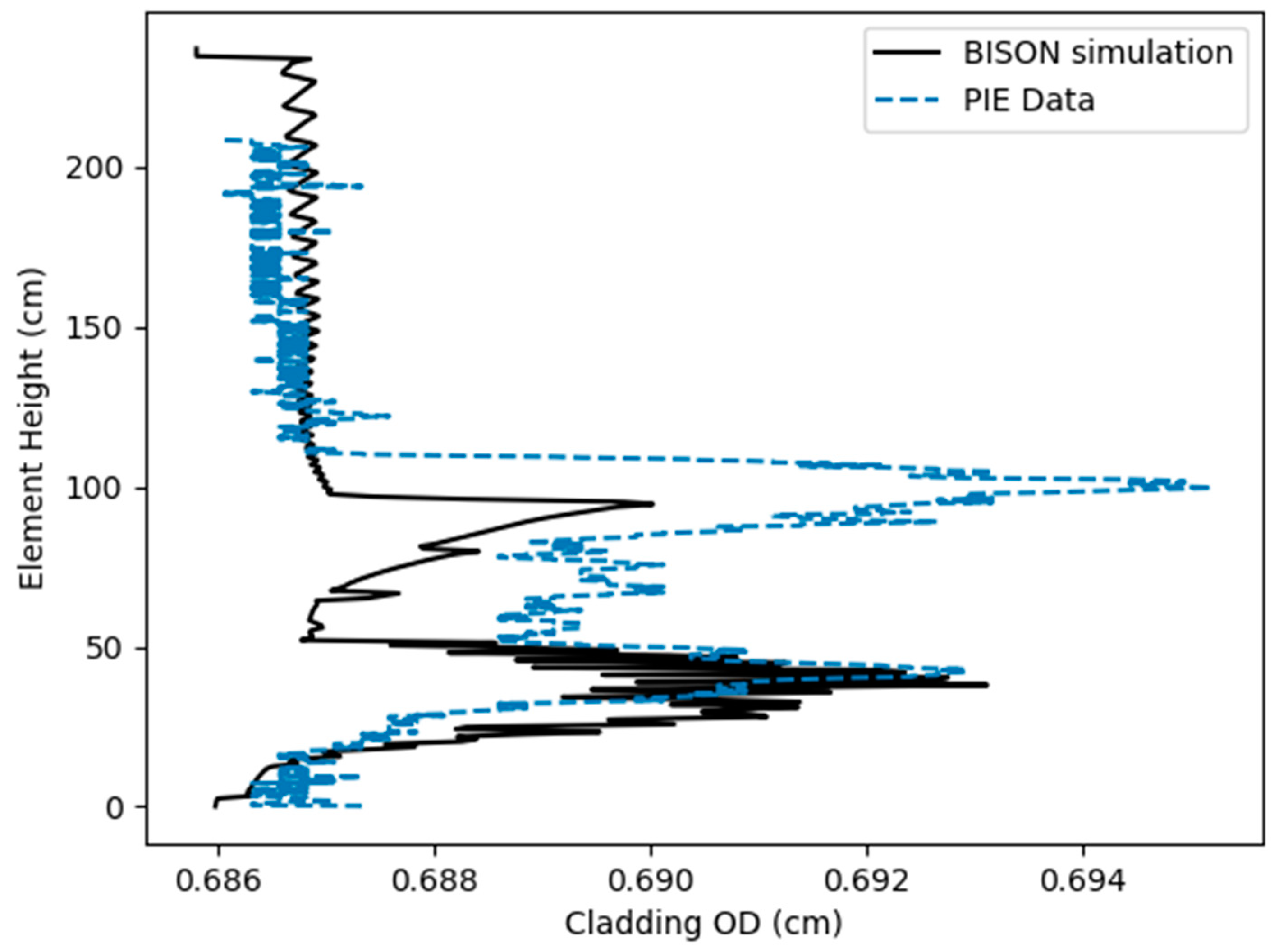
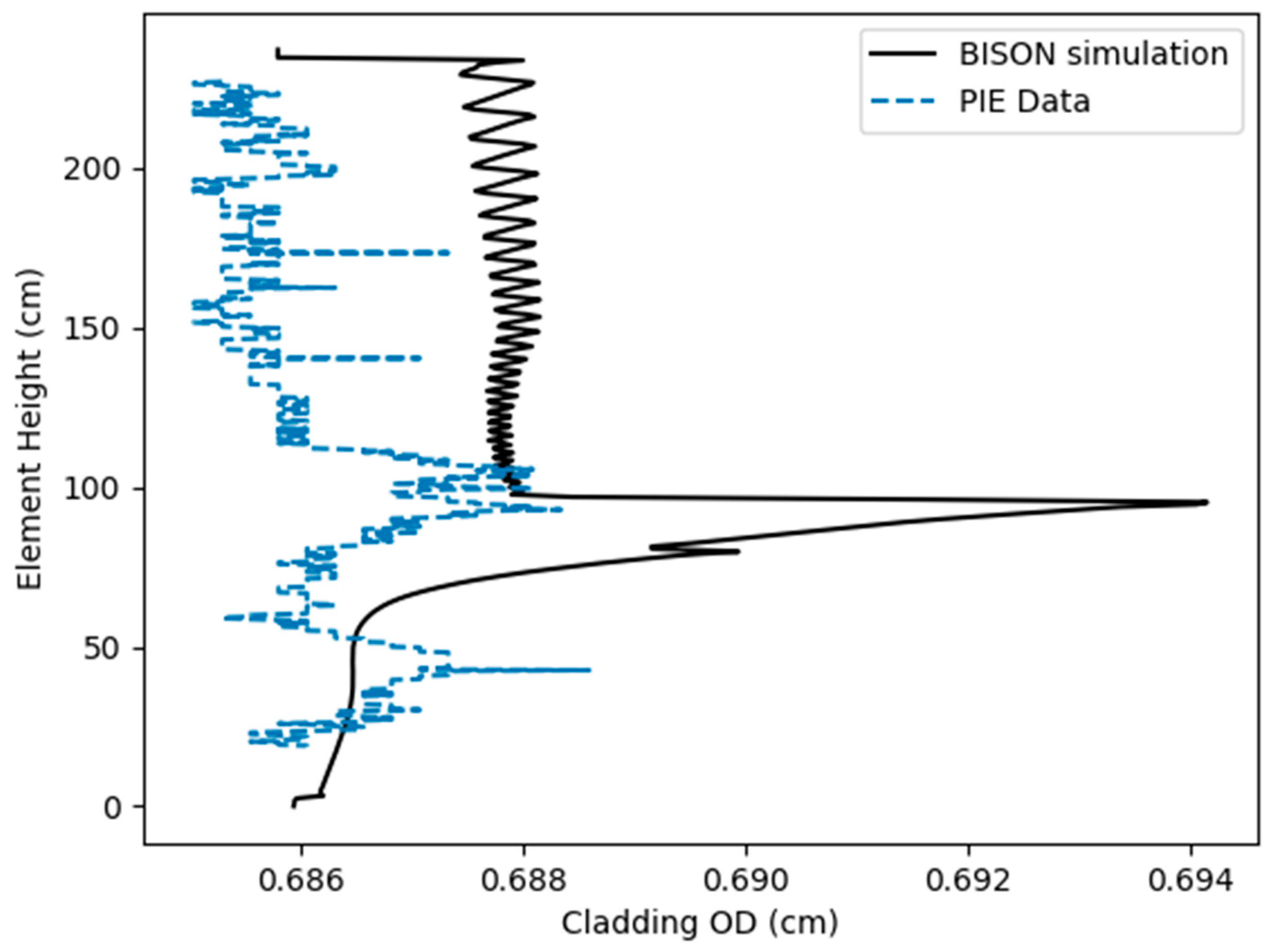
| Power Cycle | Fission Power (MW) | Fast Flux (n∙cm−2∙s−1) | Flowrate (lb∙h1) |
|---|---|---|---|
| B10C-1 | 7.94 | 2.50 × 1015 | 203,000 |
| E10C-1 | 7.72 | 2.48 × 1015 | 203,000 |
| B/E10C-2 | 7.73 | 2.48 × 1015 | 203,000 |
| B10C-3 | 7.70 | 2.47 × 1015 | 203,000 |
| E10C-3 | 7.53 | 2.46 × 1015 | 203,000 |
| B/E11A-1 | 7.39 | 2.48 × 1015 | 202,240 |
| B/E11A-2 | 7.41 | 2.48 × 1015 | 202,240 |
| B11A-3 | 7.27 | 2.44 × 1015 | 202,240 |
| E11A-3 | 7.00 | 2.43 × 1015 | 202,240 |
| B11B-1 | 7.01 | 2.47 × 1015 | 204,240 |
| E11B-1 | 6.77 | 2.45 × 1015 | 204,240 |
| B11B-2 | 6.64 | 2.42 × 1015 | 197,960 |
| E11B-2 | 6.31 | 2.39 × 1015 | 197,960 |
| B11C | 6.27 | 2.25 × 1015 | 197,790 |
| E11C | 6.13 | 2.41 × 1015 | 197,790 |
| B12A-1 | 5.89 | 2.31 × 1015 | 193,950 |
| E12A-1 | 5.80 | 2.31 × 1015 | 193,950 |
| B12A-2 | 5.76 | 2.30 × 1015 | 193,800 |
| E12A-2 | 5.68 | 2.30 × 1015 | 193,800 |
| B12B-1 | 5.91 | 2.43 × 1015 | 195,840 |
| E12B-1 | 5.81 | 2.42 × 1015 | 195,840 |
| B12B-2 | 5.71 | 2.39 × 1015 | 195,840 |
| E12B-2 | 5.62 | 2.39 × 1015 | 195,840 |
| Power Cycle | Fission Power (MW) | Flux (n∙cm−2∙s−1) | Flowrate (lb∙h−1) |
|---|---|---|---|
| B11B-1 | 7.55 | 2.40 × 1015 | 200,400 |
| E11B-1 | 7.29 | 2.39 × 1015 | 200,400 |
| B11B-2 | 7.47 | 2.60 × 1015 | 194,240 |
| E11B-2 | 7.02 | 2.56 × 1015 | 194,240 |
| B11C | 6.98 | 2.62 × 1015 | 194,070 |
| E11C | 6.79 | 2.57 × 1015 | 194,070 |
| B12A-1 | 7.13 | 2.78 × 1015 | 190,310 |
| E12A-1 | 6.93 | 2.75 × 1015 | 190,310 |
| B12A-2 | 6.98 | 2.78 × 1015 | 190,160 |
| E12A-2 | 6.79 | 2.75 × 1015 | 190,160 |
| B12B-1 | 6.87 | 2.80 × 1015 | 192,170 |
| E12B-1 | 6.68 | 2.77 × 1015 | 192,170 |
| B12B-2 | 6.70 | 2.79 × 1015 | 192,170 |
| E12B-2 | 6.52 | 2.76 × 1015 | 192,170 |
| Pin | Burnup | Axial Fuel Swelling | Cladding Profilometry | Metallography | Neutron Radiography | Gamma Scan | Fission Gas Measurements |
|---|---|---|---|---|---|---|---|
| 193020 | X | X | X | X | |||
| 193025 | X | X | X | X | |||
| 193045 | X | X | X | X | X | X | X |
| 193062 | X | X | X | X | |||
| 195011 | X | X | X | X | X | X | X |
| 195012 | X | X | X | X | |||
| 195051 | X | X | X | X | |||
| 195052 | X | X | X | X |
| Phenomenon | Fuel Model | Cladding Model |
|---|---|---|
| Fuel Phase | PhaseUPuZr [19] | N/A |
| Thermal Conductivity | ThermalUPuZr [20,21] | ThermalHT9 [22,23] ThermalD9 [22,24,25] Thermal316 [26] |
| Density (g∙cm−3) | 15.8 | 7.8 |
| Burnup | UPuZrBurnup [27] | N/A |
| Fission Rate | UPuZrFissionRate [16] | N/A |
| Elasticity Tensor | UPuZrElasticityTensor [22] | HT9ElasticityTensor [28] D9ElasticityTensor [22] |
| Creep | UPuZrCreepUpdate [22] | HT9CreepUpdate [22] D9CreepUpdate [22] |
| Thermal Expansion | UPuZrThermalExpansionEigenstrain [29] | HT9ThermalExpansionEigenstrain [25] D9ThermalExpansionEigenstrain [22,25] |
| Gaseous Swelling with Hot-pressing pore collapse | UPuZrGaseousEigenstrainwithHotPressingPuswelling [14,27,30] | N/A |
| Fission Gas Release | UPuZrFissionGasRelease [31] | N/A |
| Solid Swelling | BurnupDependentEigenstrain [14] | N/A |
| Cladding Void Swelling | N/A | HT9VolumetricSwellingEigenstrain [22] D9VolumetricSwellingEigenstrain [22] |
| FCCI | N/A | MetallicFuelWastage [16] MetallicFuelWastageDamage [16] |
| CDF | N/A | FailureCladHT9 [32] FailureCladD9 [33] |
| FFTF Fuel Pin | Average Burnup | Peak Burnup |
|---|---|---|
| 193020 | 0.117 | 0.137 |
| 193025 | 0.113 | 0.132 |
| 193045 | 0.118 | 0.139 |
| 193062 | 0.121 | 0.142 |
| 195011 | 0.087 | 0.102 |
| 195012 | 0.085 | 0.100 |
| 195051 | 0.086 | 0.101 |
| 195052 | 0.085 | 0.100 |
| FFTF Fuel Pin | BISON Simulation (mol) | IMIS Correlation Prediction (mol) | FFTF Irradiation Calculation (mol) |
|---|---|---|---|
| 193020 | 0.0318 | 0.0307 | N/A |
| 193025 | 0.0312 | 0.0300 | N/A |
| 193045 | 0.0322 | 0.0309 | 0.0367 |
| 193062 | 0.0331 | 0.0318 | N/A |
| 195011 | 0.0237 | 0.0232 | 0.0354 |
| 195012 | 0.0231 | 0.0225 | N/A |
| 195051 | 0.0235 | 0.0231 | N/A |
| 195052 | 0.0233 | 0.0229 | N/A |
| FFTF Fuel Pin | BISON Simulation (mol) | IMIS Correlation Prediction (mol) | FFTF Irradiation Measurement (mol) |
|---|---|---|---|
| 193020 | 0.0230 | 0.0226 | N/A |
| 193025 | 0.0225 | 0.0220 | N/A |
| 193045 | 0.0233 | 0.0228 | 0.0297 |
| 193062 | 0.0239 | 0.0234 | N/A |
| 195011 | 0.0171 | 0.0171 | 0.0208 |
| 195012 | 0.0166 | 0.0166 | N/A |
| 195051 | 0.0168 | 0.0170 | N/A |
| 195052 | 0.0167 | 0.0168 | N/A |
| FFTF Fuel Pin | BISON Simulation | IMIS Correlation Prediction | FFTF Irradiation Calculation |
|---|---|---|---|
| 193020 | 0.722 | 0.714 | N/A |
| 193025 | 0.721 | 0.713 | N/A |
| 193045 | 0.722 | 0.714 | 0.778 |
| 193062 | 0.723 | 0.715 | N.A |
| 195011 | 0.722 | 0.705 | 0.588 |
| 195012 | 0.717 | 0.704 | N/A |
| 195051 | 0.717 | 0.705 | N/A |
| 195052 | 0.717 | 0.705 | N/A |
| Pin | Pin Average Displacement (cm) | STD | SEE (cm) | Max Strain Difference (cm) | Ave Strain Difference (cm) |
|---|---|---|---|---|---|
| 193062 | 9.85 × 10−4 | 1.99 × 10−3 | 2.22 × 10−3 | 2.77 × 10−3 | 8.78 × 10−4 |
| 193045 | 8.77 × 10−4 | 1.59 × 10−3 | 1.82 × 10−3 | −5.93 × 10−4 | 7.84 × 10−4 |
| 193020 | 4.77 × 10−4 | 1.99 × 10−3 | 2.05 × 10−3 | 6.82 × 10−4 | 3.78 × 10−4 |
| 193025 | −6.84 × 10−4 | 1.84 × 10−3 | 1.96 × 10−3 | −2.08 × 10−3 | −7.87 × 10−4 |
| 195012 | 1.77 × 10−3 | 1.32 × 10−3 | 2.21 × 10−3 | 5.56 × 10−3 | 1.61 × 10−3 |
| 195052 | 2.05 × 10−3 | 1.54 × 10−3 | 2.57 × 10−3 | 6.45 × 10−3 | 1.93 × 10−3 |
| 195051 | 1.85 × 10−3 | 1.85 × 10−3 | 2.62 × 10−3 | 7.38 × 10−3 | 1.78 × 10−3 |
| 195011 | 2.28 × 10−3 | 1.81 × 10−3 | 2.91 × 10−3 | 8.12 × 10−3 | 2.26 × 10−3 |
| Average Total | 1.21 × 10−3 | 1.98 × 10−3 | 2.32 × 10−3 | 3.54 × 10−3 | 1.10 × 10−3 |
| Total STD | N/A | N/A | N/A | 3.89 × 10−3 | 9.99 × 10−4 |
| FFTF Fuel Pin | BISON (cm) | PIE (cm) |
|---|---|---|
| 193062 | 93.23 | 92.86 |
| 193045 | 93.44 | 92.77 |
| 193020 | 93.53 | 93.05 |
| 193025 | 92.88 | 92.86 |
| 195012 | 92.47 | 94.14 |
| 195052 | 92.51 | 94.87 |
| 195051 | 92.60 | 94.96 |
| 195011 | 92.72 | 94.78 |
Disclaimer/Publisher’s Note: The statements, opinions and data contained in all publications are solely those of the individual author(s) and contributor(s) and not of MDPI and/or the editor(s). MDPI and/or the editor(s) disclaim responsibility for any injury to people or property resulting from any ideas, methods, instructions or products referred to in the content. |
© 2023 by the authors. Licensee MDPI, Basel, Switzerland. This article is an open access article distributed under the terms and conditions of the Creative Commons Attribution (CC BY) license (https://creativecommons.org/licenses/by/4.0/).
Share and Cite
Paaren, K.M.; Gale, M.; Wootan, D.; Medvedev, P.; Porter, D. Fuel Performance Analysis of Fast Flux Test Facility MFF-3 and -5 Fuel Pins Using BISON with Post Irradiation Examination Data. Energies 2023, 16, 7600. https://doi.org/10.3390/en16227600
Paaren KM, Gale M, Wootan D, Medvedev P, Porter D. Fuel Performance Analysis of Fast Flux Test Facility MFF-3 and -5 Fuel Pins Using BISON with Post Irradiation Examination Data. Energies. 2023; 16(22):7600. https://doi.org/10.3390/en16227600
Chicago/Turabian StylePaaren, Kyle M., Micah Gale, David Wootan, Pavel Medvedev, and Douglas Porter. 2023. "Fuel Performance Analysis of Fast Flux Test Facility MFF-3 and -5 Fuel Pins Using BISON with Post Irradiation Examination Data" Energies 16, no. 22: 7600. https://doi.org/10.3390/en16227600
APA StylePaaren, K. M., Gale, M., Wootan, D., Medvedev, P., & Porter, D. (2023). Fuel Performance Analysis of Fast Flux Test Facility MFF-3 and -5 Fuel Pins Using BISON with Post Irradiation Examination Data. Energies, 16(22), 7600. https://doi.org/10.3390/en16227600




